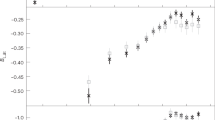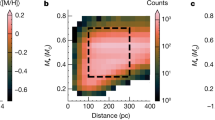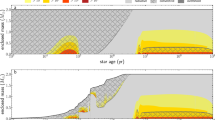Abstract
Long-period variable stars arise in the final stages of the asymptotic giant branch phase of stellar evolution. They have periods of up to about 1,000 days and amplitudes that can exceed a factor of three in the I-band flux. These stars pulsate predominantly in their fundamental mode1,2,3, which is a function of mass and radius, and so the pulsation periods are sensitive to the age of the underlying stellar population4. The overall number of long-period variables in a population is directly related to their lifetimes, which is difficult to predict from first principles because of uncertainties associated with stellar mass-loss and convective mixing. The time variability of these stars has not previously been taken into account when modelling the spectral energy distributions of galaxies. Here we construct time-dependent stellar population models that include the effects of long-period variable stars, and report the ubiquitous detection of this expected ‘pixel shimmer’ in the massive metal-rich galaxy M87. The pixel light curves display a variety of behaviours. The observed variation of 0.1 to 1 per cent is very well matched to the predictions of our models. The data provide a strong constraint on the properties of variable stars in an old and metal-rich stellar population, and we infer that the lifetime of long-period variables in M87 is shorter by approximately 30 per cent compared to predictions from the latest stellar evolution models.
This is a preview of subscription content, access via your institution
Access options
Subscribe to this journal
Receive 51 print issues and online access
$199.00 per year
only $3.90 per issue
Buy this article
- Purchase on Springer Link
- Instant access to full article PDF
Prices may be subject to local taxes which are calculated during checkout




Similar content being viewed by others
References
Fox, M. W. & Wood, P. R. Theoretical growth rates, periods, and pulsation constants for long-period variables. Astrophys. J. 259, 198–212 (1982)
Wood, P. R. & Sebo, K. M. On the pulsation mode of Mira variables: evidence from the Large Magellanic Cloud. Mon. Not. R. Astron. Soc. 282, 958–964 (1996)
Ita, Y. et al. Variable stars in the Magellanic Clouds — II. The data and infrared properties. Mon. Not. R. Astron. Soc. 353, 705–712 (2004)
Vassiliadis, E. & Wood, P. R. Evolution of low- and intermediate-mass stars to the end of the asymptotic giant branch with mass loss. Astrophys. J. 413, 641–657 (1993)
Tonry, J. & Schneider, D. P. A new technique for measuring extragalactic distances. Astron. J. 96, 807–815 (1988)
Tonry, J. L. et al. The SBF survey of galaxy distances. IV. SBF magnitudes, colors, and distances. Astrophys. J. 546, 681–693 (2001)
Blakeslee, J. P. et al. The ACS Fornax cluster survey. V. Measurement and recalibration of surface brightness fluctuations and a precise value of the Fornax-Virgo relative distance. Astrophys. J. 694, 556–572 (2009)
van Dokkum, P. G. & Conroy, C. Fluctuation spectroscopy: a new probe of old stellar populations. Astrophys. J. 797, 56 (2014)
Groenewegen, M. A. T. & Blommaert, J. A. D. L. Mira variables in the OGLE bulge fields. Astron. Astrophys. 443, 143–156 (2005)
Soszyński, I. et al. The Optical Gravitational Lensing Experiment. The OGLE-III catalog of variable stars. IV. Long-period variables in the Large Magellanic Cloud. Acta Astronom. 59, 239–253 (2009)
Soszyński, I. et al. The Optical Gravitational Lensing Experiment. The OGLE-III catalog of variable stars. XV. Long-period variables in the Galactic bulge. Acta Astronom. 63, 21–36 (2013)
Salpeter, E. E. The luminosity function and stellar evolution. Astrophys. J. 121, 161–167 (1955)
Waters, C. Z., Zepf, S. E., Lauer, T. R. & Baltz, E. A. Color bimodality in M87 globular clusters. Astrophys. J. 693, 463–471 (2009)
Peng, E. et al. The color-magnitude relation for metal-poor globular clusters in M87: confirmation from deep HST/ACS imaging. Astrophys. J. 703, 42–51 (2009)
Bird, S. et al. The inner halo of M 87: a first direct view of the red-giant population. Astron. Astrophys. 524, A71 (2010)
Conroy, S. & van Dokkum, P. G. The stellar initial mass function in early-type galaxies from absorption line spectroscopy. II. Results. Astron. Astrophys. 760, 71–87 (2012)
Gould, A. Search for intracluster MACHOs by pixel lensing of M87. Astrophys. J. 455, 44–49 (1995)
Baltz, E. A. et al. Microlensing candidates in M87 and the Virgo Cluster with the Hubble Space Telescope. Astrophys. J. 610, 691–706 (2004)
Ferrarese, L., Côté, P. & Jordán, A. Hubble Space Telescope observations of novae in M49. Astrophys. J. 599, 1302–1319 (2003)
Kormendy, J., Fisher, D. B., Cornell, M. E. & Bender, R. Structure and formation of elliptical and spheroidal galaxies. Astrophys. J. 182 (Supp.), 216–309 (2009)
Villaume, A., Conroy, C. & Johnson, B. Circumstellar dust around AGB stars and implications for infrared emission from galaxies. Astrophys. J. 806, 82 (2015)
Marigo, P. et al. Evolution of asymptotic giant branch stars. II. Optical to far-infrared isochrones with improved TP-AGB models. Astron. Astrophys. 482, 883–905 (2008)
Smith, B. J., Leisawitz, D., Castelaz, M. W. & Luttermoser, D. Infrared light curves of Mira variable stars from COBE DIRBE data. Astron. J. 123, 948–964 (2002)
Kuntschner, H. et al. The SAURON project — XVII. Stellar population analysis of the absorption line strength maps of 48 early-type galaxies. Mon. Not. R. Astron. Soc. 408, 97–132 (2010)
Wood, P. R., Bessell, M. S. & Fox, M. W. Long-period variables in the Magellanic Clouds — supergiants, AGB stars, supernova precursors, planetary nebula precursors, and enrichment of the interstellar medium. Astrophys. J. 272, 99–115 (1983)
Fliri, J., Riffeser, A., Seitz, S. & Bender, R. The Wendelstein Calar Alto Pixel-lensing Project (WeCAPP): the M 31 variable star catalogue. Astron. Astrophys. 445, 423–439 (2006)
Davidge, T. J. & Rigaut, F. Photometric variability among the brightest asymptotic giant branch stars near the center of M32. Astrophys. J. 607, L25–L28 (2004)
Rejkuba, M., Minniti, D. & Silva, D. R. Long period variables in NGC 5128. I. Catalogue 2. Astron. Astrophys. 406, 75–85 (2003)
Acknowledgements
We thank M. Groenewegen for discussions. C.C. thanks B. Holden and C. Rockosi for asking the question that provided the spark for this paper: ‘can one detect Mira variables in integrated light?’
Author information
Authors and Affiliations
Contributions
C.C. constructed the models, led the data processing, and contributed to the analysis and interpretation. P.G.v.D. contributed to the analysis and interpretation. J.C. generated the stellar evolution models and contributed to the analysis and interpretation.
Corresponding author
Ethics declarations
Competing interests
The authors declare no competing financial interests.
Extended data figures and tables
Extended Data Figure 1 Flux of background galaxies.
Shown is the time variation of the flux of three background galaxies. The background galaxies should show no intrinsic time variation in their flux and therefore serve as a test of the stability of the data. The mean (μ) and standard deviation (σ) are reported in each panel. The 1σ error on each point due to photon counting uncertainty is 0.09%. The solid line is a 5-point boxcar average. a, Flux variation after the standard data reduction including the primary sky background correction. The arrow indicates a point that lies at −2.1. b, Flux variation after additional corrections were applied to the sky background levels. These additional corrections allow us to achieve a stability of ~0.1% for boxcar-averaged time series data.
Extended Data Figure 2 Flux variation distributions.
Shown is the normalized distribution of (maximum−minimum)/mean fluxes over the 72 observing windows, separated into three bins of counts per second (ct/s). The data (black lines) are compared to the best-fit model (red lines) and a noise-only model (blue dotted lines). Also shown in each panel is the number of pixels, Npix, contributing to the distribution.
Extended Data Figure 3 Amplitude versus period for luminous variable stars.
Data are for Galactic bulge stars from the OGLE survey11 measured in the I band. The distinct classes of Miras, semi-regular variables (SRVs), and OGLE small-amplitude red giants (OSARGs) are shown as red, green, and blue symbols. Lines are the adopted sequences for Miras and SRVs; these relations are used to assign pulsation amplitudes in our model.
Extended Data Figure 4 Long-period variable (LPV) star flux contribution versus age, wavelength, and metallicity.
a, Fractional contribution to the total luminosity versus age in four bandpasses: I (0.8 μm), z (0.9 μm), J (1.2 μm), and K (2.4 μm). The flux contribution scales approximately as t−1/2. b, Flux contribution versus age and metallicity for the I and K bandpasses. The metallicity range shown encompasses the observed variation in M87 within Re.
Extended Data Figure 5 Radial variation of model properties for M87.
a, Stellar mass per pixel for the smooth underlying model for M87 as a function of R/Re where Re is the effective radius. b, Fraction of pixels with |slope/error| > 2. c, Fraction of pixels in a noise-free model with >1% peak-to-peak flux variation over 200 d. d, Strength of surface brightness fluctuation (SBF) signal at a single epoch compared to the mean temporal variation due to variable stars in a noise-free model.
Rights and permissions
About this article
Cite this article
Conroy, C., van Dokkum, P. & Choi, J. Ubiquitous time variability of integrated stellar populations. Nature 527, 488–491 (2015). https://doi.org/10.1038/nature15731
Received:
Accepted:
Published:
Issue Date:
DOI: https://doi.org/10.1038/nature15731
Comments
By submitting a comment you agree to abide by our Terms and Community Guidelines. If you find something abusive or that does not comply with our terms or guidelines please flag it as inappropriate.



